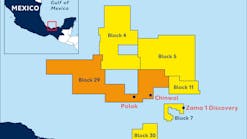Ultra-deepwater spar study gets underway
Halliburton KBR has been awarded a contract for a conceptual engineering study of a Spar/deep draft caisson vessel (DDCV) in 10,000 ft water depth in the Gulf of Mexico. The research and development study is sponsored and funded by the DeepStar coalition, which is supported by 15 oil company participants and 50 contributor companies.
The study involves engineering and costing of a Spar/DDCV for very large topsides and a large number of risers in ultra-deepwater. The contract specifies an application on a high pressure/high temperature reservoir. Three options for mooring system and riser design will be investigated:
- Steel mooring with steel risers
- Polyester mooring with steel risers
- Polyester mooring with composite risers.
A team of engineers from Halliburton KBR's offshore technology division began work on the project in early October. The study should be completed in March 2002. The contract's scope of work includes providing conceptual design and analyses; developing major operations sequences, and identifying key equipment needed for fabrication and installation; developing cost and schedule estimates; and documenting analyses, design, drawings, schedules, costs, findings, and recommendations.
SBM novel fluid transfer system
At the recent Deep Offshore Technology Conference in Rio de Janeiro, Single Buoy Mooring introduced its concept for a gravity actuated pipe (GAP) to transfer fluids from deepwater fields while avoiding flow assurance issues. A number of deepwater developments will require the use of a floating production, storage, and offloading (FPSO) vessel combined with one or several dry-tree completion units (DCUs).
Traditionally, raw production would flow from the DCU to the FPSO through seabed flowlines. In deepwater, these lines are exposed to high pressures and very cold temperatures that can induce hydrate or wax formation, blocking flow. A near-surface flowline solution would avoid these problems, but this is difficult to achieve because of the high number of flow functions required, including two-phase flow. The SBM concept would avoid this by transferring the fluids at a mid-water level.
The GAP is made up of a rigid horizontal portion of flowlines assembled in a bundle with two vertical portions of flexible jumpers (these vertical portions also could be composed of steel lines with swivels). The vertical jumpers attach the carrier pipe to the FPSO and DCU.
The carrier pipe structurally supports the flowline bundle.
The carrier pipe is one continuous pipe that provides for flowline attachment and bundle buoyancy, giving the bundle neutral buoyancy in normal flow density conditions. At each end of the rigid central section are chains attaching it to the FPSO and DCU respectively, at a predetermined angle. At the same point on the carrier pipe, clump weights, are suspended on chains below the carrier pipe ends. The action of the weights on the angled chain between the pipe bundle and floaters keeps the pipe carrier under tension.
This tension keeps the hog/sag deflections of the pipe bundle within acceptable limits when either the transferred fluid densities of the distance between the FPSO and DCU vary. This tension also controls all lateral deflections of the bundle under the effect of currents. The GAP was developed for the offshore West Africa and Brazil markets and has the flexibility to transfer any number of fluids between floaters in various development scenarios.
Oregano production onstream
Shell E&P announced the Oregano field is now producing 11,000 b/d from two wells through a subsea production system. Oregano is located on Garden Banks Block 558 and 559 in the Gulf of Mexico. Shell, which owns 100% of this project, said production began 14 months after project sanction. The target reserves, in the K sands at a depth of approximately 19,000 ft subsea, are oil and associated gas. API gravity for the oil is 35-37°. Sulfur content is approximately 1.08%.
Shell's Oregano development in the Gulf of Mexico.
Located about 225 miles southwest of New Orleans in approximately 3,400 ft water depth, Oregano ties back 8 miles, via a subsea manifold, to Shell's Auger tension-leg platform. The subsea system consists of two wells connected to a subsea-flowline sled that is tied back to Auger via a single 6-in. by 10-in. pipe-in-pipe insulated flowline. This is the Auger hub's second subsea development. Macaroni, which began production in 1999, was the first subsea tie-in to Auger. For transportation from the subsea manifold to Auger, Oregano uses a single production flowline, as opposed to the traditional two-flowline loop.
Steve Sears, Subsea Development Manager for Shell, said Oregano is forecast to come in about $10 million under budget. Development costs for Oregano are approximately $120 million, excluding lease costs. Total gross ultimate recovery is estimated at 50 million BOE with peak production of 20,000 b/d expected by year's end. Major contractors participating in the development are Diamond Offshore, drilling and completions; J. Ray McDermott, flowline installation; Bayou Pipe Coaters, flowlines; Oil States, flowlines; Seacat, umbilicals; Duco, umbilicals; Oceaneering, subsea pig launcher; FMC, subsea wellhead and completion equipment; and W.S. Nelson/Linder & Associates and Bay Offshore, topsides.
KOP lands Lost Ark
Kværner Oilfield Products (KOP) announced it will supply the electro-hydraulic multiplex control system for Noble Affiliates' Lost Ark development in the Gulf of Mexico. The contracts covers equipment located subsea and on the host platform used for control and testing of the wells. On the platform, KOP will provide a hydraulic power unit to generate the hydraulic pressure needed to operate the subsea tree valves, manifold valves, and the surface-controlled subsea safety valves. A master control station computer located in the host facility is the primary operator interface and will be capable of operating the trees.
Subsea, Kværner will supply the umbilical termination assembly, flying leads, and a subsea control module. Testing and installation equipment will also be supplied for the system integration and testing and for installation and commissioning work. The Lost Ark subsea development is located in East Breaks blocks 420, 421, 464, and 465 in 2,750 ft water depth. The field will connect to a platform 27 miles away.






